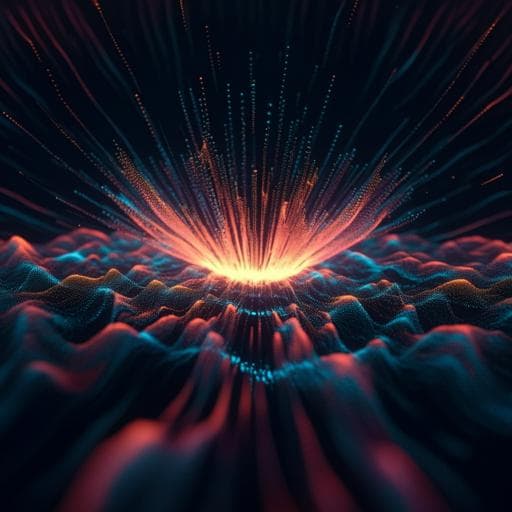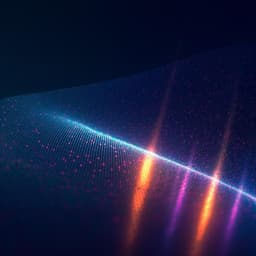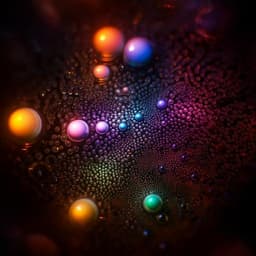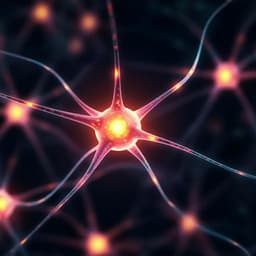
Engineering and Technology
Fast non-line-of-sight imaging with high-resolution and wide field of view using synthetic wavelength holography
F. Willomitzer, P. V. Rangarajan, et al.
Discover the groundbreaking Non-Line-of-Sight imaging technique, Synthetic Wavelength Holography, developed by Florian Willomitzer and colleagues. This innovative method achieves sub-mm resolution and captures complete object fields within milliseconds, unlocking exciting applications across various fields.
~3 min • Beginner • English
Introduction
Non-line-of-sight (NLoS) imaging seeks to recover images of objects that are obscured by opaque barriers or scattering media (e.g., walls, fog, tissue). Existing active NLoS methods typically fall into two categories: time-of-flight (ToF) techniques that exploit the finite speed of light, and speckle/memory-effect (ME) techniques that exploit angular correlations in scattered light. ToF approaches can operate over larger working volumes but generally require raster scanning of large intermediary areas and offer cm-scale resolution. ME-based approaches achieve high lateral resolution with small probing areas but suffer from very narrow angular fields of view due to angular decorrelation. The central research goal of this work is to develop an imaging method that overcomes the FoV–resolution trade-off by leveraging spectral correlations in scattered light, enabling high-resolution, wide-FoV NLoS imaging with minimal measurements and a small probing area. The proposed solution, Synthetic Wavelength Holography (SWH), forms a hologram at a synthetic wavelength by mixing complex fields measured at two closely spaced optical wavelengths, enabling robust phase recovery and numerical backpropagation to reconstruct hidden objects.
Literature Review
Active NLoS imaging has advanced along two main fronts. (1) Time-of-flight (ToF) methods use temporally modulated illumination and fast detectors to reconstruct hidden surfaces via virtual source/detector scanning on intermediary surfaces. Recent ToF work shows cm-scale lateral resolution over ~1 m volumes and near real-time reconstructions, but often requires raster scanning large wall areas and specialized ultrafast hardware. (2) Speckle correlation/memory-effect (ME) methods exploit spatial/angular correlations in scattered light to achieve high lateral resolution (<100 µm at 1 m) with small probing areas (< few cm). However, ME-based methods are restricted to narrow angular FoVs (often <2° for drywall) and limited object sizes constrained by the memory-effect working volume. Prior multi-wavelength interferometry on rough surfaces established that phase is preserved at scales of a synthetic wavelength much larger than optical wavelength, suggesting spectral correlations as a path to robust phase retrieval through scattering. SWH builds on these insights to generalize holography to scattered wavefronts without requiring transmission matrices or extensive scanning.
Methodology
Core principle: SWH exploits spectral correlations of speckle fields generated by coherent illumination at two closely spaced optical wavelengths λ1 and λ2. The complex fields E(λ1)=A1 exp(i φ(λ1)) and E(λ2)=A2 exp(i φ(λ2)) are recorded; computational mixing E(Δ)=E(λ1) E*(λ2)=A1 A2 exp(i(φ(λ1)−φ(λ2))) yields a synthetic hologram at the synthetic wavelength Δ=λ1 λ2 / |λ1−λ2|, which is orders of magnitude larger than the optical wavelengths. The synthetic phase φ(Δ)=φ(λ1)−φ(λ2) remains correlated despite strong scattering, enabling numerical backpropagation at Δ to reconstruct hidden objects.
Acquisition setups:
- Looking around corners (reflective NLoS): Use a wall region as a virtual source (VS) to illuminate the hidden object and another wall region as a virtual detector (VD) imaged onto a lock-in focal plane array (FPA). Two complex fields at λ1, λ2 are captured and mixed to form the synthetic hologram at VD, then backpropagated to the object plane.
- Imaging through scatter (transmissive NLoS): Illuminate and capture fields through a scattering layer (e.g., diffuser or milky plastic). As above, form the synthetic hologram from two wavelengths and backpropagate at Δ.
Detection and interferometry: Complex fields are measured interferometrically using frequency heterodyning with a lock-in FPA (Heliotis C3), exploiting heterodyne gain for low-light NLoS conditions. Two architectures were implemented:
1) Dual-wavelength heterodyne interferometer: Two CW DFB lasers (center 855 nm, tuning range ~2.6 nm) are shuttered sequentially to acquire E(λ1) and E(λ2). A small reference modulation vm≈3 kHz (via AOM/EOM) enables lock-in detection. The LI-FPA outputs in-phase (I) and quadrature (Q) images per wavelength: I=A cos φ, Q=A sin φ. Synthetic hologram E(Δ) is formed by complex mixing of the two measurements. Pros: high light throughput; Cons: sensitive to motion/environment between shots.
2) Superheterodyne interferometer: Both lasers illuminate simultaneously with controlled AOM phase shifts ΔΦAOM; lock-in at vm provides I,Q containing contributions from both wavelengths. Multiple phase-shifted measurements recover the synthetic phase. Pros: robust to environmental fluctuations and motion and can enable single-shot synthetic amplitude-only holography; Cons: additional optical components reduce throughput.
Imaging parameters and processing: The LI-FPA records 300×300 pixel frames with exposure t_exp≈23 ms; two-shot SWH acquisition totals ~46 ms. Probing area in experiments is ~58 mm × 58 mm. Synthetic holograms are backpropagated using an angular spectrum propagator at Δ. Resolution follows a synthetic diffraction limit δx≈Δ z / D, where D is the diameter of the VD area and z is propagation distance.
Speckle diversity: To mitigate synthetic speckle from spectral decorrelation at small Δ, reconstructions can be incoherently averaged over multiple VS positions to improve image quality with few additional measurements.
Synthetic pulse holography (multi-wavelength extension): By recording at many regularly spaced optical wavelengths and coherently combining the corresponding synthetic fields, SWH forms a computational synthetic pulse train (akin to OCT/WLI but without arm matching), improving axial resolution and enabling depth sectioning with a defined ambiguity determined by the frequency step.
Wavefront sensing through scatter: Mixing fields from adjacent wavelengths across a broad sweep yields a synthetic phase map at selected Δ, revealing residual phase structure in speckled wavefronts transmitted through volumetric scattering, enabling wavefront characterization without ballistic light.
Reference beam injection: A lensed fiber needle provides a planar reference with reduced radiometric loss versus a 50/50 beam splitter and allows direct lens-to-camera threading.
Key Findings
- High-resolution, wide-FoV NLoS imaging with a small probing area: SWH recovers holographic representations of hidden targets with sub-millimeter lateral resolution using a ~58 mm × 58 mm probing area and captures the complete object field within ~46 ms (two exposures of ~23 ms each), enabling a nearly hemispherical angular field of view.
- Around-corner imaging (reflective NLoS): Reconstructed a hidden 15 mm × 20 mm character ('N') by backpropagating synthetic holograms at multiple synthetic wavelengths Δ: 1.30 mm, 0.92 mm, 0.61 mm, 0.56 mm, 0.44 mm. Resolution improves as Δ decreases, consistent with holography.
- Synthetic diffraction limit validated: Localized a point source at z=95 mm using VD diameter D≈8 mm. Measured synthetic diffraction disc sizes scale with δx≈Δ z / D. Achieved sub-mm resolution (δx≈0.8 mm) at Δ=0.28 mm.
- Imaging through scattering media (transmissive NLoS): Through a 220-grit diffuser, reconstructions of a 15 mm × 20 mm 'U' remained high quality down to ≈Δ=0.36 mm; at Δ=0.28 mm synthetic speckle artifacts appear. Through a ~4 mm thick milky white plastic plate (pronounced multiple scattering), 'U' was reconstructed for Δ≥0.36 mm. Independent correlation measurements indicated smallest speckle-artifact-free Δ≈300 µm (diffuser) and ≈400 µm (plastic), matching observed artifact onset.
- Synthetic pulse holography (axial sectioning): For two characters separated by Δz=33 mm, single-Δ (0.8 mm) reconstructions show limited depth separation, while coherent combination across Nλ=23 synthetic wavelengths (frequency step 25 GHz) yields depth sectioning with a periodic ambiguity of ~12 mm; a ~1 GHz step would provide an unambiguous range >33 mm. Demonstrated feasibility for improved longitudinal resolution.
- Wavefront sensing through volumetric scatter: Using external data with wavelength sweep 690–940 nm and adjacent-wavelength mixing produced a synthetic phase at Δ≈2.1 mm for samples of thickness 720 µm and 1080 µm (mean free path 90 µm). Recovered structured phase consistent with known interferometric artifacts; ballistic paths were negligible (suppressed by ~10^-8 and ~10^-12, respectively).
- Practicalities: Heterodyne lock-in FPA sensing at vm≈3 kHz with two CW DFB lasers (center 855 nm, tuning ~2.6 nm) provided synthetic wavelengths down to ~300 µm and robust operation under low-return NLoS conditions.
Discussion
SWH addresses the core NLoS challenge of simultaneously achieving high spatial resolution, wide angular field of view, and fast acquisition with a small probing area. By leveraging spectral correlations in scattered wavefronts, SWH recovers robust phase at a synthetic wavelength and uses holographic backpropagation to reconstruct hidden scenes. This decouples resolution (set by Δ) from carrier wavelength while tolerating strong scattering that destroys optical-wavelength phase. The experiments validate sub-mm lateral resolution around corners, imaging through both surface scatter and volumetric scatter, axial sectioning via synthetic pulse holography, and wavefront sensing through scatter. SWH operates with continuous-wave sources and full-field FPAs, avoiding ultrafast sources/detectors and raster scanning common in ToF systems. These attributes enable new application spaces: inspection in confined spaces with small probing areas, early-warning navigation with wide FoV, medical/forensic imaging requiring high spatial resolution, and dynamic scene capture with high temporal resolution. The framework generalizes classical holography to scattered wavefronts and suggests extensions to other wave modalities (e.g., ultrasound, radio, X-ray), potentially decoupling penetration depth (carrier) from resolution (synthetic frequency).
Conclusion
The paper introduces Synthetic Wavelength Holography, a holographic NLoS imaging approach that exploits spectral correlations to form synthetic-wavelength holograms, enabling sub-mm resolution over near-hemispheric FoV with two-shot acquisition from a small probing area. Demonstrations include around-corner imaging, imaging through diffusers and volumetric plastic, validation of the synthetic diffraction limit, synthetic pulse holography for improved axial resolution, and wavefront sensing through scatter. SWH circumvents limitations of ToF and ME-based methods and operates with CW lasers and lock-in FPAs. Future research directions include: optimizing Δ selection guided by spectral memory and the Rayleigh quarter-wave criterion; robust, single-shot superheterodyne implementations; integration with FMCW LiDAR for long-range fog scenarios; ultrasound-assisted focusing for deeper tissue imaging; frequency-comb locking for enhanced axial resolution; and adaptation to other wave regimes (ultrasound, X-ray, radio/THz) to decouple resolution from penetration depth.
Limitations
- Spectral decorrelation (spectral memory effect): If fields at λ1 and λ2 are uncorrelated, synthetic phase cannot be recovered, causing synthetic speckle artifacts. Practical operation requires judicious Δ selection.
- Rayleigh quarter-wave criterion (RQWR): Largest wavefront error γ_max introduced by scattering should satisfy γ_max ≤ Δ/4 to preserve phase; otherwise reconstructions degrade. For surface scatter, γ_max relates to surface roughness; for volumetric scatter, it scales with L^2 / l* (thickness squared over transport mean free path).
- Trade-offs with Δ: Smaller Δ improves resolution but increases decorrelation and artifacts. Measured minimum artifact-free Δ were ~300 µm (diffuser) and ~400 µm (plastic plate) in this work.
- Motion/environmental sensitivity: Time-sequential dual-wavelength acquisition is sensitive to object motion and environmental fluctuations between shots; superheterodyne improves robustness but reduces optical throughput due to added components.
- Light-starved conditions: NLoS paths yield very low return; although heterodyne gain helps, available laser power and throughput limit performance.
- Volumetric scattering and long-range scenarios: Large γ_max in thick media or long paths (e.g., fog) limits maximal achievable resolution; auxiliary strategies (e.g., time-gating with FMCW LiDAR) may be necessary.
- Depth ambiguity in synthetic pulse holography: Axial sectioning with periodic frequency steps introduces depth ambiguity determined by the step size (e.g., 25 GHz → ~12 mm), requiring finer steps (≈1 GHz) for larger unambiguous ranges.
Related Publications
Explore these studies to deepen your understanding of the subject.







